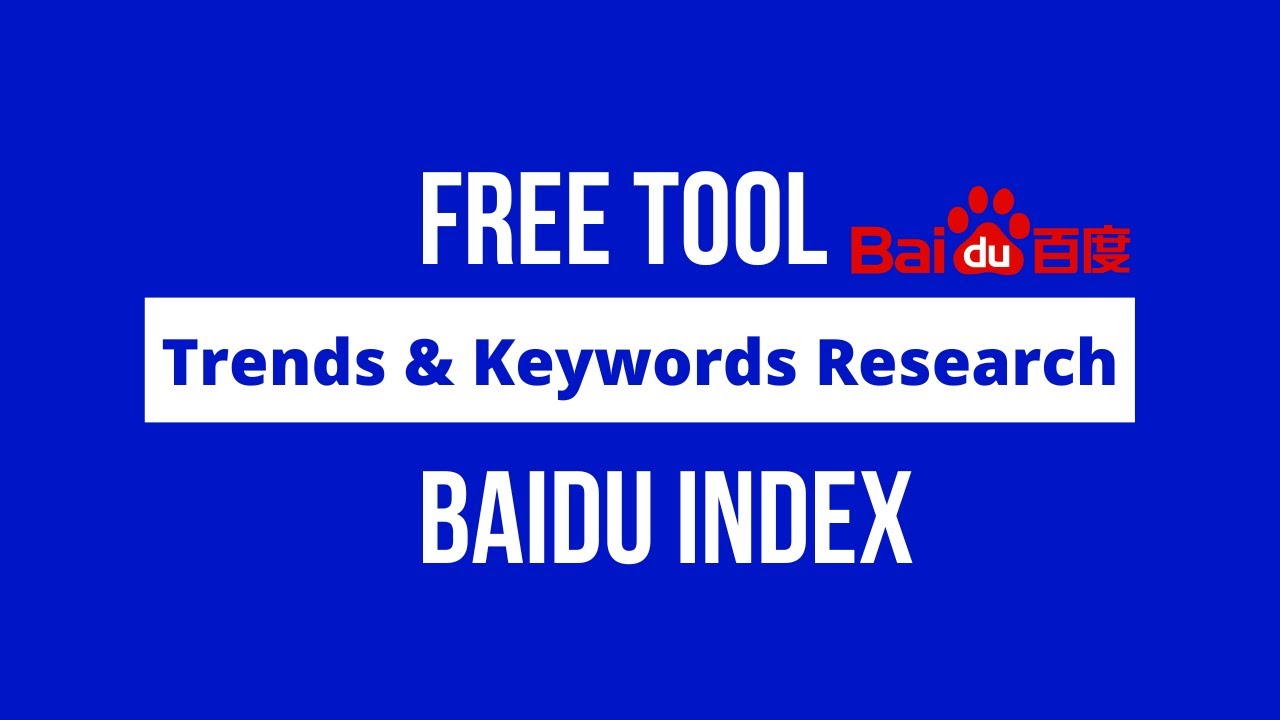Baidu Index is a pivotal tool for marketers navigating the Chinese digital landscape.
Functioning akin to Google Trends, it offers insights into search trends and keyword popularity on Baidu, China’s dominant search engine.
Marketers utilize this data to craft targeted content, optimize SEO strategies, and track the performance of campaigns in the Chinese market.
By analysing search volume and trending topics, businesses can stay ahead of consumer interests and adapt their marketing tactics accordingly.
Baidu Index serves as an indispensable resource for understanding and capitalizing on the dynamic nuances of the Chinese online ecosystem, aiding businesses in achieving their objectives effectively.
———————————-
When we talk about trends and keyword research, Google Trends and Google Analytics will come to mind. But it doesn’t work well in the Chinese market.
Google Trends analyses the popularity of top search queries in Google Search across various regions and languages. Both Google Trends and Google Analytics are blocked in Mainland China. If you want to get accurate data for your business in China’s market.
We highly recommend the Baidu Index tool to get the data. In this video, we will show you what’s Baidu Index is, what kind of data we can get and how to use it for trends and keyword research.
Baidu Index is a free tool developed by Baidu company, it shows you the trends for different industries, the demand data, and the user’s demographics. It’s one of the most valuable tools for your business in China. Baidu Index was launched on July 29, 2006.
It covers the data from June 2006 on PC and January 2011 on mobile devices.
You may want to know where the data comes from. The data comes from Baidu users. Baidu app has more than 600 million monthly active users at the end of 2021.
First, let’s access the Baidu Index website, the URL is www2.baidu.com.
We added the link in the video description section. You may need a translation extension for using this tool, such as a Google Translate extension.
With just one click, you can translate the whole page into the English version. Before learning the Baidu Index tool, we need to log into the Baidu account. You can’t access the Baidu Index tool without a Baidu account.
Let me show you how to sign up on Baidu first. Please make sure to subscribe to our channel, we will share more marketing information for businesses in China.
I will show you different ways to sign up on Baidu. Let’s get started. First, access to Baidu website, or just click the Baidu link we added in the description section.
One option is you can use the social media account you have got to log in, it’s available for QQ accounts, Weibo accounts, and WeChat accounts. Let’s try to use a WeChat account to log in.
Click on the WeChat icon, it shows the QR code. We need to use the WeChat app to scan the QR code and choose the “Allow” option to confirm the login.
The green check mark means you successfully log in. If you want to use a QQ or Weibo account to log in, the process is similar. Just click on the social media button, then use your phone to scan the QR code.
Then confirm on your phone. Another way is to sign up with your phone number. When you open the Baidu website, then click sign up. Here is the information we need to fill in, username, phone number, and password.
Then click on “verification code”.
Enter the verification code you received by SMS. Then click on “register”. Well done, you already got a Baidu account. Now, let’s come back over to Baidu Index, first, you can list some keywords that you want to do research on. Then we can type one keyword in the Baidu Index search bar.
We will take iPhone for example. We type the iPhone in the search bar, then click on the “explore” button. Now we come to the page of the Baidu index search result. Let’s check what kind of data we can get from the Baidu Index search result. At the top of this page, we will see 3 sections which show at the top of this page.
The first one is Trends Research, The second one is Demand Data, The third one is Audience Demographics. We will talk more one by one. First, let’s check the Baidu Trends Research. In this section, the function is similar to Google Trends.
Here is the example we got from Google Trends.
We can add different keywords for comparison. We can add up to 5 keywords for comparison. For example, we add the other phone brands, Xiaomi and Huawei for comparison.
We can choose the keywords trends in different time arrange. There are different options here, such as last real-time, 7 days, last 30 days, last 90 days, etc. Also, you can set a custom time range. When we do research on the trends for a keyword, we need to set a bit longer time range.
Just like we check the stock market index, we usually check the data in a different time period. For checking the trends and keywords in China’s market, we recommend you check at least 90 days or half a year of data, so you can get a whole idea of the trends and accurate research results.
Let’s check the data of different models of the iPhone. You can select the average option, it will be an average line that helps you to compare the trends. Here are some factors you need to focus on: The whole trend in the time period you select.
Which time does it have a big increase or decrease? What’s the reason?
These are really important. Now, let’s back to the example data of the iPhone 13. You can see that iPhone 13 has been one of the hottest selling products during the past 6 months in China. It started increasing at the end of May and reached the top on June 18.
Why?
Because one of the largest shopping festivals–called June 18. It started on May 21 and ended on June 18. All the eCommerce platforms got promotions during that shopping festival. iPhone 13 was the best-selling phone at June 18 shopping festival in China. We can also select the devices, three different data options: 1: PC + Mobile, 2.
Mobile, 3. data on PC. Meanwhile, you can select the specific city you want to target, such as Shenzhen, Shanghai, Guangzhou, etc. Scroll down, we can view the daily search data for the keywords on PC and mobile devices. Now, let’s check the second section of Baidu Index Demand Data.
It’s like Radar, the centre is the keyword you want to research. The circle in red means the demand is increasing, and the green circle means the demand is failing. The bigger the circle is, the higher the demand will be.
Below the Radar demand map, you can check the keywords’ popularity and related topics. Right now, we will go on with the third section: Audience Demographics.
The translation sometimes shows as “crowd”. First, we need to check the location. You can select the time range first. In this section, there is a map of China. The deeper blue shows it has a higher search result.
There are 660 cities in China. The cities are divided into 4 tiers by Gross Domestic Product and population. Tier 1 cities have over 15 million people and the GDP is US$300 billion. There are 4 Tier 1 cities, Beijing, Guangzhou, Shanghai, and Shenzhen.
The Tier 2 cities have 3-15 million people, a GDP between $68 billion to $299 billion, such as There are 30 Tier 2 cities, for example, Kun Ming, Xiamen, Da Lian, Zhu Hai, etc.
If you want your marketing to be more effective, you can choose the specific city to sell your products or services. Scroll down, so we can check the age and gender of the audience. We can see the groups of age 20-29 and 30-39 share more than 60%. And men share more ratio than women. At the bottom of this page, it shows the related topics that audiences are interested in.
Ok, right now, we will check the “latest news” section. You can find it at the top of the Baidu Index page. On this page, you can find the latest announcements, industrial news, and hot topics. Most of them are professional reports. The reports are in Chinese version, you can find people to translate the document for you if there is any document you are interested in.
There is another feature of the Baidu Index that we need to mention here is Baidu Industry ranking. On the top of the Baidu Index page, click on the “Industry Ranking Index” button which is beside the “latest news” button.
It covers 7 industries, including Automobiles, Cosmetics, Mobile phones, Tourist attractions, University, Infant milk formulas, and Real estate. Let’s take the Cosmetics industry for example. This is only part of the ranking information, you can click on the “More cosmetic industry lists” button to get more data.
Now, we can check the full data here. We can check the data on a specific day or a week. You can click the calendar to choose the day or week you need.
There are 4 different sections here: The first one is Brand Index, which shows the top 20 cosmetics brands in China. The second section shows the top 20 cosmetics that users search on Baidu, including search items, images, videos, news, etc.
The third one is the brand information index, this data comes from the users’ views, likes, sharing, etc. The fourth section is Brand Interaction Information. It refers to the interaction behaviour of users on Baidu web pages, pictures, videos, and other channels and apps.
By now, we have learned the general information about the Baidu Index tool. Hope you can find the best business trends and keywords for your business in China.
Read More: How to create personalized web experiences
Read More: Website Design For Small Business








